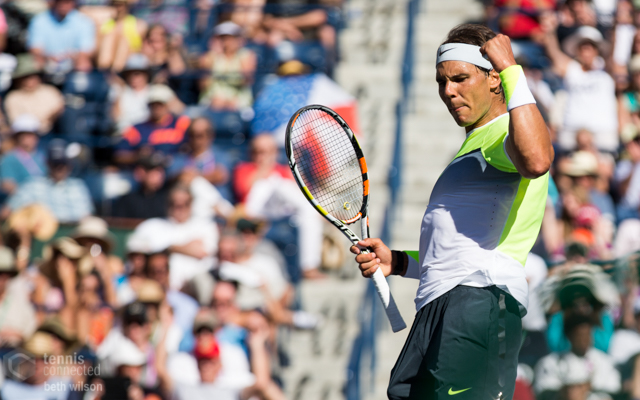Rafael Nadal dropped to his knees on the clay court with elation after his 7-5, 7-5 championship win over Fabio Fognini in front of a full capacity, roaring crowd.
It wasn’t odd to see Nadal celebrate yet another clay-court title, but it was odd to see him do it after Wimbledon.
While the majority of the Top 10 took their talents to the North American hard court swing, the then-world No. 10 lingered back in Europe and tweaked his summer plans, deciding to make an appearance at the Bet-At-Home Open in Hamburg, Germany instead.
The Spaniard’s decision to return to the Rothenbaum after a seven-year absence was a tactical attempt to improve upon his lowest ranking in a decade. The tournament offered up 500 points for the winner, which would also assist the former No. 1’s efforts to make the ATP World Tour Finals.
Nadal’s struggles and mishits have been heavily documented since returning to the tour in 2015 after an injury-plagued late-2014 campaign.
Dismayed “Rafans” and critics alike have speculated on the causes of Nadal’s slump and tennis legend John McEnroe has even gone so far to suggest that Nadal needs to cut the cord with life-long coach Uncle Toni.
But, the solution is much simpler than destroying family relationships forever or taking early retirement a la Andy Roddick.
The secret to Nadal “rebounding” (he’s still 39-12, it’s not Ernest Gulbis bad yet) is simply confidence.
Nadal has mentioned his lack of confidence previously this year. While the Spaniard has always been noted for being humble and downplaying his successes, he’s not being modest this time, he’s being absolutely candid.
But what exactly is his lack of confidence doing to his game?
In an interview with Perform, former Wimbledon champion Marion Bartoli made an interesting observation. She concluded that Nadal’s level had slipped purely because he is hitting the ball “25 kilometers per hour slower.”
While there was no statistical basis to Bartoli’s observation, it only takes a quick Google to compare Nadal’s stroke speed from his 2014 French Open final trouncing of Djokovic to being trounced in the 2015 quarterfinals in Paris by the Serb.
It’s evident that not only is Nadal hitting and serving slower, but he’s also leaving the balls so short in the court, he’s practically asking to have winners blasted by him.
The third set of his 2015 French Open quarterfinal meeting with Djokovic is a clear indicator of Nadal’s mental state. He hit the balls increasingly shorter and toward the middle of the court, evidently afraid of going after his zinging, line-grazing forehands that fans had become so accustomed to.
Even prior to the French Open, the 29-year-old’s tentative play was put on display. Nadal reached the finals of Madrid in May against Andy Murray – who is anything but a clay court specialist. But, the newlywed Brit came out and stunned practically everyone by thrashing the King of Clay 6-3, 6-2.
Once again, Nadal was seen hesitantly hitting balls short and toward the center of the court, rarely going for any blistering groundstrokes down the lines. On the other side of the net, Murray was dancing along the baseline, hitting decisive shots that kept the Spaniard scrambling from side to side, often chipping his backhand meekly over the net.
Other times, Nadal’s mind seemed to be in a fog as he wildly shanked and mishit easy shots.
Nadal’s cautious and slower play is the most blatant sign of petering confidence. For a man once known for his unparalleled fight and tenacity, it is almost awkward to watch him slowly fade away in matches and resort to feeding the ball short and toward the middle, seemingly praying for his opponent to make an amateur mistake.
While the current No. 9 sporadically shows “classic Nadal” greatness during matches, it’s obvious he lacks the confidence to maintain his aggressive style of play throughout the match in order to easily overcome his opponents.
It’s much easier said than done, but Nadal needs to reclaim the once-unwavering confidence that made him a staple of the legendary Big Four. Once he has recaptured the right mental attitude, he will return to fearlessly ripping seemingly impossible shots from anywhere on the court.
Anyone know a good sports psychologist?















